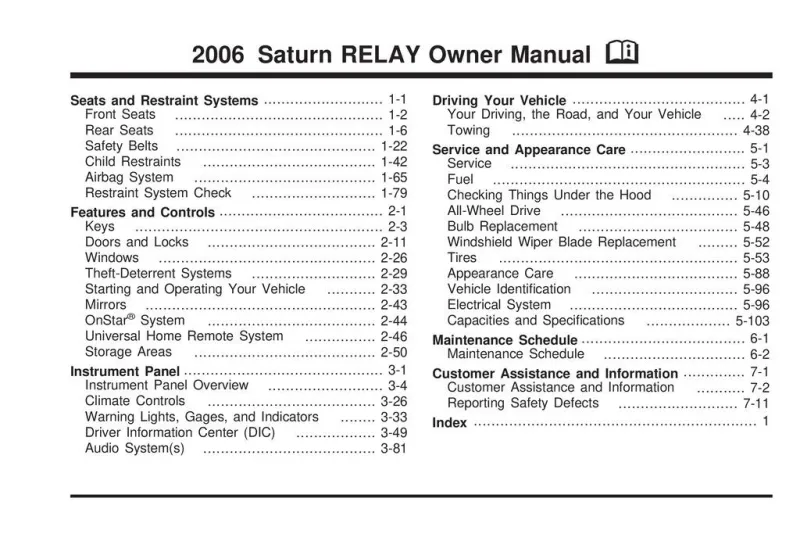2006 Saturn Relay Owner's Manual

Table of Contents
2006 Saturn Relay Overview
Introduction
The 2006 Saturn Relay is a versatile and spacious minivan designed to accommodate families and travelers alike. With its practical layout and thoughtful features, the Relay brings a comfortable driving experience combined with ample cargo space. This model is a beacon of reliability and functionality for those in need of a vehicle that can cater to their everyday needs, making it a notable choice in the minivan market.
Powertrains
The 2006 Saturn Relay offers a powerful and efficient powertrain option that caters to various driving preferences. Under the hood, it features a robust 3.5-liter V6 engine that delivers solid performance with approximately 200 horsepower. This engine is paired with a 4-speed automatic transmission, ensuring smooth gear transitions and a responsive driving experience. The Relay boasts respectable fuel efficiency, making it an economical option for family road trips and daily commutes.
Trims
Saturn Relay comes in four distinct trims: the base model, the RELAY 1, RELAY 2, and the top-of-the-line RELAY 3. Each trim offers a unique set of features and amenities, allowing buyers to choose a model that best fits their lifestyle. The higher trims add luxuries such as leather seating, enhanced audio systems, and advanced safety features, transforming the Relay into a premium family vehicle.
Features
This minivan is laden with family-friendly features, including quad sliding doors for easy access, a spacious interior with seating for up to seven passengers, and a customizable cargo area. Notable highlights include an optional rear entertainment system, tri-zone climate control for personalized comfort, and an available navigation package that ensures you never lose your way on family adventures.
Owner's Manual
The 2006 Saturn Relay comes equipped with a comprehensive owner's manual that provides essential information regarding maintenance, safety features, and troubleshooting tips. This crucial resource enhances the ownership experience by ensuring that drivers are well-informed about vehicle care and operation, contributing to prolonged performance and reliability.
User manual download
The Saturn Relay owner manual for the 2006 model year is to be found in PDF downloadable format on this page. The owner manual for the model year 2006 is free and in English, but the repair manuals are usually not easy to get and may cost more.
Manual Questions
Fill the form below and someone will help you!
